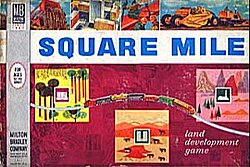|
Square Mile (board game)
Square Mile was the land development board game released by Milton Bradley in 1962. It is for 2–4 players. GameplayThe square mile is divided into sixteen tracts, most of which are zoned (at the beginning of the game) for certain types of development. Each player has the role of a real estate developer starting the game with $100,000 and one free tract (decided randomly). Then there is a round where players bid on additional tracts that may be had at very cheap prices; the number of tracts that each player bids on is determined by how many players are in the game. Then a number of road segments are built: One plus one per player. The rest of the game, players take turns, each of which consists of the following phases:
Market value of a tract depends on how it is zoned and the state of development. The market value and development costs are shown on a chart that is visible to all players. The game ends when the last tract of land is bought that is not fully developed. Then players total the amount of cash that they have plus the market value of tracts owned. The player with the greatest total is the winner. ReceptionIn the March 1989 edition of Games International (Issue #3), Phil Orbanes mourned the loss of this game, saying, "At the risk of exaggerating, I think the game was nothing less than a sheer delight to behold — and play." After reviewing its strong points and the mistakes in marketing that he believed had led to its demise, Orbanes concluded, "If brought back today, Square Mile might need some modernisation, but its essential play qualities would be very attractive to all game players who enjoy financial manipulation."[1] References
External links |
||||||||||||||||

